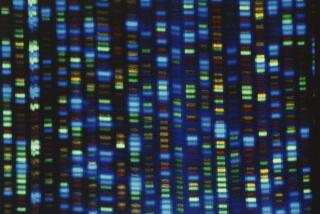Studies map key spots on African Americans’ genomes
- Share via
Two independent research teams have used a new method to develop the first detailed maps of the places where DNA is likely to be reshuffled in the genomes of African Americans, creating a tool that will help find genes that cause disease, scientists reported Wednesday.
The new maps pinpoint thousands of “hot spots” on chromosomes where recombination — a gene-swapping process that is crucial to creating genetic diversity but is sometimes linked to disease — is likely to occur.
The knowledge will help researchers uncover the genetic underpinnings of illness in all people but particularly in African Americans, said Harvard Medical School geneticist David Reich, the senior author of a study published online by the journal Nature. To date, medical genetics studies have focused almost exclusively on people of European descent.
“African Americans have a unique gene structure,” he said. “If they’re not studied, we won’t find the genes that cause disease.”
Reich’s team, co-led by University of Oxford statistician Simon Myers, looked at DNA data collected from 29,589 unrelated African Americans who had participated in various genetic studies around the U.S. With so many subjects, Reich said, the map is the most accurate available for any population.
The team found about 2,500 hot spots that were active in people of West African descent but scarce among Europeans.
The second team, led by UCLA geneticists, looked at DNA from 2,864 African Americans and African Caribbeans and also found significant differences from European DNA. The UCLA researchers published their results online in the journal Nature Genetics.
To construct the maps, both teams took advantage of a unique characteristic in African Americans: Their genes are a relatively recent blend of European and West African DNA.
Reich likened the blending of genetic heritages to editing film.
Individuals produce eggs or sperm containing long sections of DNA from each of their parents. Much like reels of film, those sections are cut and spliced together. The splices are the locations where recombination occurs.
Since the mixture of African and European DNA in African Americans has taken place over just six generations, on average, each person’s reel of film has only broken up a handful of times.
That leaves “a mosaic of large, unbroken chunks of genetic information” in African Americans’ genes, Reich said. The scientists compared those long chunks to known sequences of African and European DNA and figured out where the recombination hot spots were located.
In populations where genetic mixing took place further in the past, such as South Asians, the DNA has been cut and spliced more times, Reich said. This results in smaller chunks of genetic information that are too short to compare to reference genomes.
In such populations, scientists building recombination maps will have to rely on the same methods used in Europeans. These include comparing an individual’s DNA to that of his or her relatives to figure out where recombination has occurred.
UC Davis geneticist Graham Coop, who was not involved in either study, praised both for their statistical elegance. “What’s nice is the replication,” he added. “You’re getting two groups independently coming to similar conclusions.”
The human genome is more than 99% identical in humans of all backgrounds. But, Coop said, “there are some differences — and those differences are biologically interesting.”
Until now, scientists have had to rely on maps built with DNA from people of European descent. Having more-accurate maps for African Americans should help scientists plot the genes that cause them to develop diseases — both common conditions like heart disease and cancer, as well as yet-to-be-identified ailments that are unique to the group.
“More and more we’re appreciating the importance of diversity in doing medical studies,” said UCLA geneticist John Novembre, coauthor of the smaller study. “It’s not always a one-size-fits-all approach.”
Both Reich and Novembre said they would next like to map the recombination hot spots in Latinos, who have a mix of European, Native American and African ancestry, stretching back about nine generations.







